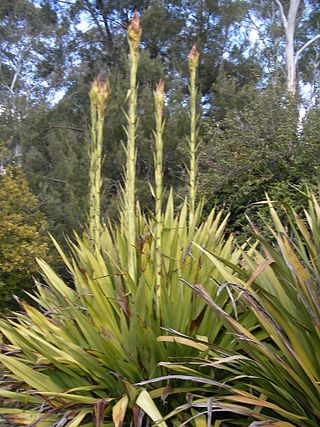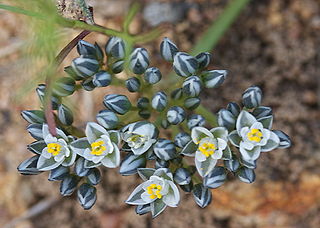
Austrobaileyales is an order of flowering plants consisting of about 100 species of woody plants growing as trees, shrubs and lianas. The best-known species is Illicium verum, commonly known as star anise. The order belongs to the group of basal angiosperms, the ANA grade, which diverged earlier from the remaining flowering plants. Austrobaileyales is sister to all remaining extant angiosperms outside the ANA grade.

The Buxales are a small order of eudicot flowering plants, recognized by the APG IV system of 2016. The order includes the family Buxaceae; the families Didymelaceae and Haptanthaceae may also be recognized or may be included in the Buxaceae. Many members of the order are evergreen shrubs or trees, although some are herbaceous perennials. They have separate "male" (staminate) and "female" (carpellate) flowers, mostly on the same plant. Some species are of economic importance either for the wood they produce or as ornamental plants.

Griselinia is a genus of seven species of shrubs and trees, with a highly disjunct distribution native to New Zealand and South America. It is a classic example of the Antarctic flora. It is the sole genus in the family Griseliniaceae. In the past it was often placed in Cornaceae but differs from that in many features.
Lophopyxis is a genus of flowering plants and the sole genus of the family Lophopyxidaceae. The group consists of two species of tendrillate lianas. They are found in the Sunda Islands.

Nelumbonaceae is a family of aquatic flowering plants. Nelumbo is the sole extant genus, containing Nelumbo lutea, native to North America, and Nelumbo nucifera, widespread in Asia. At least five other genera, Nelumbites, Exnelumbites, Paleonelumbo, Nelumbago, and Notocyamus are known from fossils.

Pentaphragma is a genus of flowering plants. Pentaphragma is the sole genus in Pentaphragmataceae, a family in the order Asterales. These species are fleshy herbs, with asymmetrical leaf blades. They are found in Southeast Asia. Pentaphragma is rayless, but eventually develops rays in at least one of the species studied. This is interpreted as related to secondary woodiness or upright habit within a predominantly herbaceous phylad. The vessel elements of Pentaphragma have features universally interpreted as primitive in dicotyledons: scalariform perforation plates with numerous bars; pit membrane remnants in perforations; scalariform lateral wall pitting; the genus also has fiber-tracheids with prominently bordered pits. The presence of occasional scalariform perforation plates, often aberrant, in secondary xylem of families of Asterales sensu lato - Campanulaceae, Pentaphragmataceae, Valerianaceae, and even Asteraceae - can be attributed to paedomorphosis, extending these plates into secondary xylem from primary xylem. Raylessness in Pentaphragma can be described in terms of secondary woodiness or paedomorphosis. The fact that fiber-tracheids are shorter than vessel elements in Pentaphragma is believed related to raylessness also, because some fiber-tracheids are produced from 'potential' ray areas.
Phelline is a genus of shrubs and the sole member of the family Phellinaceae, a family of flowering plants endemic to New Caledonia. It is placed in the order Asterales and is related to two other small plant families: Alseuosmiaceae and Argophyllaceae. It contains ten species.

Gomortega keule is a species of tree endemic to Chile. It is the sole species of the genus Gomortega and, according to the APG IV system of 2016, of the monotypic family Gomortegaceae, assigned to the order Laurales in the clade magnoliids.

Goupia is a neotropical genus of flowering plants and the sole genus included in the family Goupiaceae. There are three species, all found in tropical northern South America.

Peridiscaceae is a family of flowering plants in the order Saxifragales. Four genera comprise this family: Medusandra, Soyauxia, Peridiscus, and Whittonia., with a total of 12 known species. It has a disjunct distribution, with Peridiscus occurring in Venezuela and northern Brazil, Whittonia in Guyana, Medusandra in Cameroon, and Soyauxia in tropical West Africa. Whittonia is possibly extinct, being known from only one specimen collected below Kaieteur Falls in Guyana. In 2006, archeologists attempted to rediscover it, however, it proved unsuccessful.
Physena is the sole genus of the flowering plant family Physenaceae. It contains two species of shrubs and small trees which are endemic to Madagascar. The APG II system, of 2003, does recognize this family and assigns it to the order Caryophyllales in the clade core eudicots.

Doryanthes is the sole genus in the flowering plant family Doryanthaceae. The genus consists of two species, D. excelsa and D. palmeri, both endemic natives of the coast of Eastern Australia. Doryanthaceae is part of the order Asparagales.

Daphniphyllum is the sole genus in the flowering plant family Daphniphyllaceae and was described as a genus in 1826. The genus includes evergreen shrubs and trees mainly native to east and southeast Asia, but also found in the Indian Subcontinent and New Guinea.

Phyllonoma is a genus consisting of 4 species of trees and shrubs. Phyllonoma is the sole genus in the family Phyllonomaceae. Phyllonoma species are native to South and Central America.

Koeberlinia is a genus of flowering plant. It is the sole genus in the family Koeberliniaceae. Alternately it is treated as a member of the Capparaceae.

Vahlia is a genus of herbs and subshrubs that grow in Africa and the Indian subcontinent. There are at least five species.

Fouquieria is a genus of 11 species of desert flowering plants, the sole genus in the family Fouquieriaceae. The genus is native to North America and includes the ocotillo and the Boojum tree or cirio. They have semi succulent stems with thinner spikes projecting from them, with leaves on the bases spikes. They are unrelated to cacti and do not look much like them; their stems are proportionately thinner than cactus stems and their leaves are larger.

Oncotheca is a genus of tree endemic to New Caledonia. There are two species, Oncotheca balansae and Oncotheca humboldtiana.

Limeum is a genus of flowering plants. It includes 25 species.

Plocosperma is the sole genus in the Plocospermataceae, a family of flowering plants. The genus contains a single species, Plocosperma buxifolium.

















